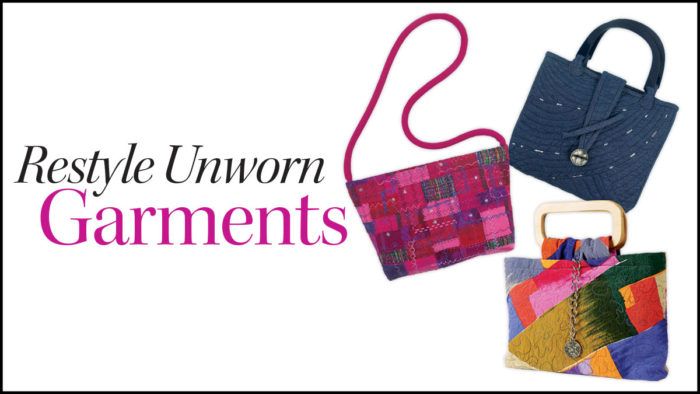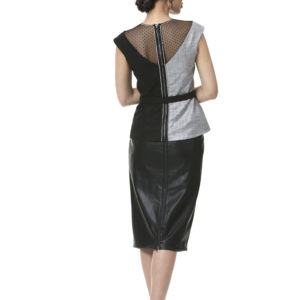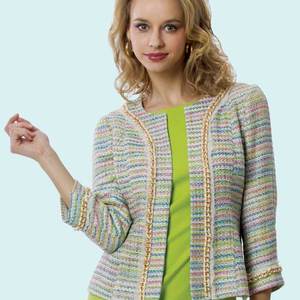Restyle Unworn Garments
Obsolete clothes become one-of-a-kind bags
If you’re a devoted sewer like me, it’s likely that your wardrobe is full of unique garments you’ve crafted, using fine fabrics and time-consuming techniques. As wonderful as these clothes are, they don’t stay in style forever—or maybe they don’t fit your current figure or lifestyle. Though you can’t wear them, you also can’t bear to part with them. What’s the solution?
My answer combines conservation and innovation in equal parts. I design handbags that take full advantage of what’s special in a garment: the fabric, the embellishment, or a nifty design detail.
Why recycle? Why make bags?
Style-oriented women may thrive on novelty, but that doesn’t mean they’re environmentally unconscious. In today’s “green” world, most of us think twice before simply discarding clothes. We also tend to have strong emotional bonds to our clothing, especially pieces we’ve designed and made ourselves.
So it only makes sense to consider remaking those garments as something new. Handbags are an ideal upcycling project. By working with clothes from your existing wardrobe, you’ll end up with accessories that match your preferred color palette. You don’t have to worry about fitting, so you can create anything your original garment’s fabric will accommodate. Even clothes with relatively little yardage, like vests, can be transformed into workable bags. With careful planning, you can use nearly every square inch of a garment (don’t overlook linings or facings, either.) If the original fabric is lightweight, try reinforcing it with fusible or sew-in interfacings intended for garments or bags, or by quilting.
Clever engineering—and a willingness to see beyond the contours of the coat, jacket, or vest you started with—enable you to come up with intriguing accessories that share the spirit of the garment, but have a fresh, updated form and function.
Harvest design elements
Get extra mileage from fancy embellishments, prefinished fabric edges, or interesting construction details.
You can cut around applied decorations so they enhance your new project just as well as the old one. And, with careful planning, you can cut apart garments in such a way as to give existing details a new function.

Turn over a new leaf
Layered, machine-embroidered leaves were formerly a dickey that snapped into a jacket. The appliquéd leaves fell vertically at the jacket’s front, but when turned sideways, they make a perfect embellishment for a silk evening clutch.

Inside out
Don’t ignore the interiors of garments. I easily converted the embellished lining of a denim duster into an attractive tote, retaining the fabric-origami hydrangeas I had lovingly folded. These flowers aren’t hard to make by folding small fabric circles, but they take time, so I was delighted to be able to feature them on the outside of this bag.

All the trimmings
This cheery, red fleece bag started out as a child’s jacket—outgrown before it was ever worn. To take advantage of the mitten-shaped, zippered pocket and multiple rows of decorative trim, I converted it into a book bag, using leftover ribbon to cover and stabilize the seams and strap.

In-vest-ment in style
Vests are quick to sew, but creating a lush chenille texture takes time. When I was finished wearing this chenille vest, I redesigned it as a bag. Here, the original bound armholes now form the straps; the vest’s side seams are positioned in the center of the bag front and back. Additional binding around the outer edges matches the loop-and-button closure, for a soft but sturdy, textured hobo.

Purse-sueded
A pink ultrasuede jacket once seemed like a good idea, but when it was completed, I found I looked like a wad of bubblegum wearing it. The fabric was wonderful, though, and perfect for this series of bags. First, I cut the lower front so I could use the large pockets on a rectangular shoulder bag. The jacket’s belt became the shoulder strap, and the sleeve belts now encircle the top opening.

Embellished trio
The remaining fabric from the jacket back, sleeves, and collar was sufficient to cut three smaller purses, as well. Abstract pin-weaving, a superb plastic buckle, self-fabric tassels, and wrist loops adorn these chic zippered and flap clutches.
Reap from what you’ve sewn
If you’ve retired a glamorous garment—for whatever reason—let it live on as a drop-dead gorgeous accessory. There’s no reason you can’t continue to enjoy the ultrafancy fabric in smaller doses. Or, use quilted clothes for softly structured bags. In most cases, you won’t need to add interfacing or bag stiffeners, because the fabric has enough body on its own.

Little black bag
In the opulent ’80s, I bought this magnificent, metallic-striped fabric for $100 a yard. By the time I drummed up the courage to cut it, I realized the fabric was too over-the-top for the intended project. However, it turned out to be perfect for a pair of baguette-style evening purses. As you can see, both sides of the fabric can handle the spotlight, and look entirely contemporary doing so.

Scrappy remix
This simple little shoulder bag demands attention due to its bright color and busy surface. To make it, I cut and fused rectangles of fabrics to a piece of sturdy interfacing, cut to the size of the bag. The fun came in stitching over the entire surface with assorted decorative stitches, which hold the rectangle edges in place, stiffen the fabric, and create a vibrant, one-of-a-kind pattern.

Quilted carry-all
I fell in love with this wildly printed silk fabric, and planned to make a jacket. To create the textured, lofty surface, I stipple-stitched the silk to a cotton flannel backing, then washed and dried it. By the time I had cut out the garment, I realized it was going to be overwhelming to wear. This print cried out to be an eye-catching accessory, instead. With wooden handles and a simple, boxy shape, all it needed was a unique closure: I added part of a decades-old chain belt to complete my boho-deluxe tote.

Denim do-over
I loved the swirly lines of quilting and subtle surface embellishment on this denim vest. However, I never wore it and realized it was more suited to being a casual handbag. I simply cut off the bottom half of the vest back, which had a slightly curved hem. I trimmed the piece into a rectangle to construct the bag (adding purchased handles), and used the leftover curved hem strip as button-tipped fastener that slides under a denim cord to close.
Shirley Adams is a designer, teacher, and former television host, who now sells one-of-a-kind purses at her “Hundred Handbags” gallery events. Learn more at SewingConnection.com.






























Log in or create an account to post a comment.
Sign up Log in